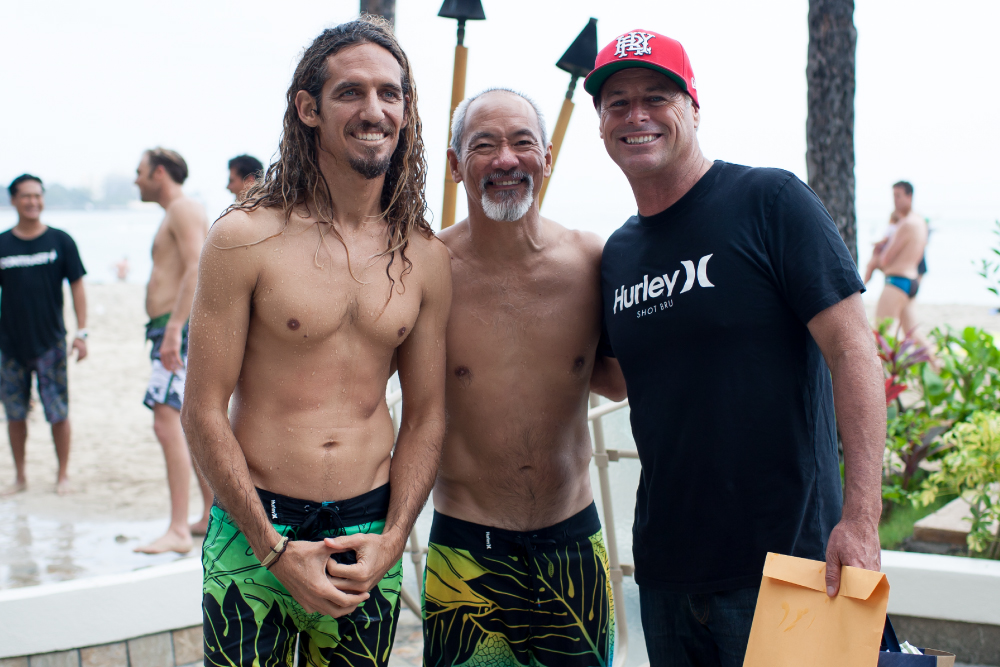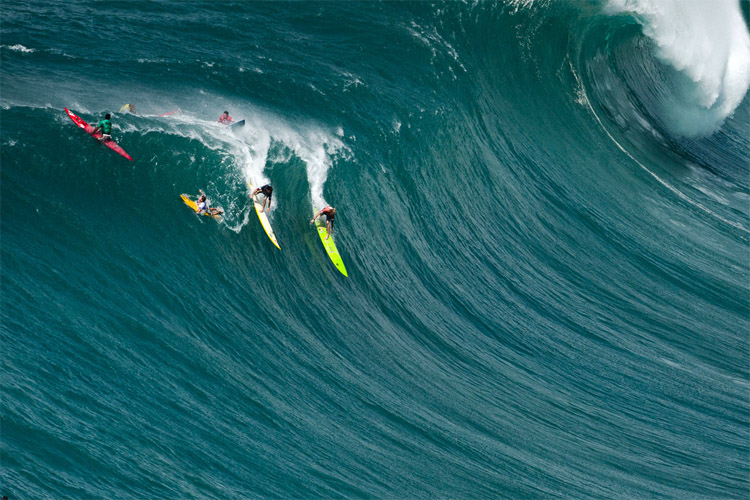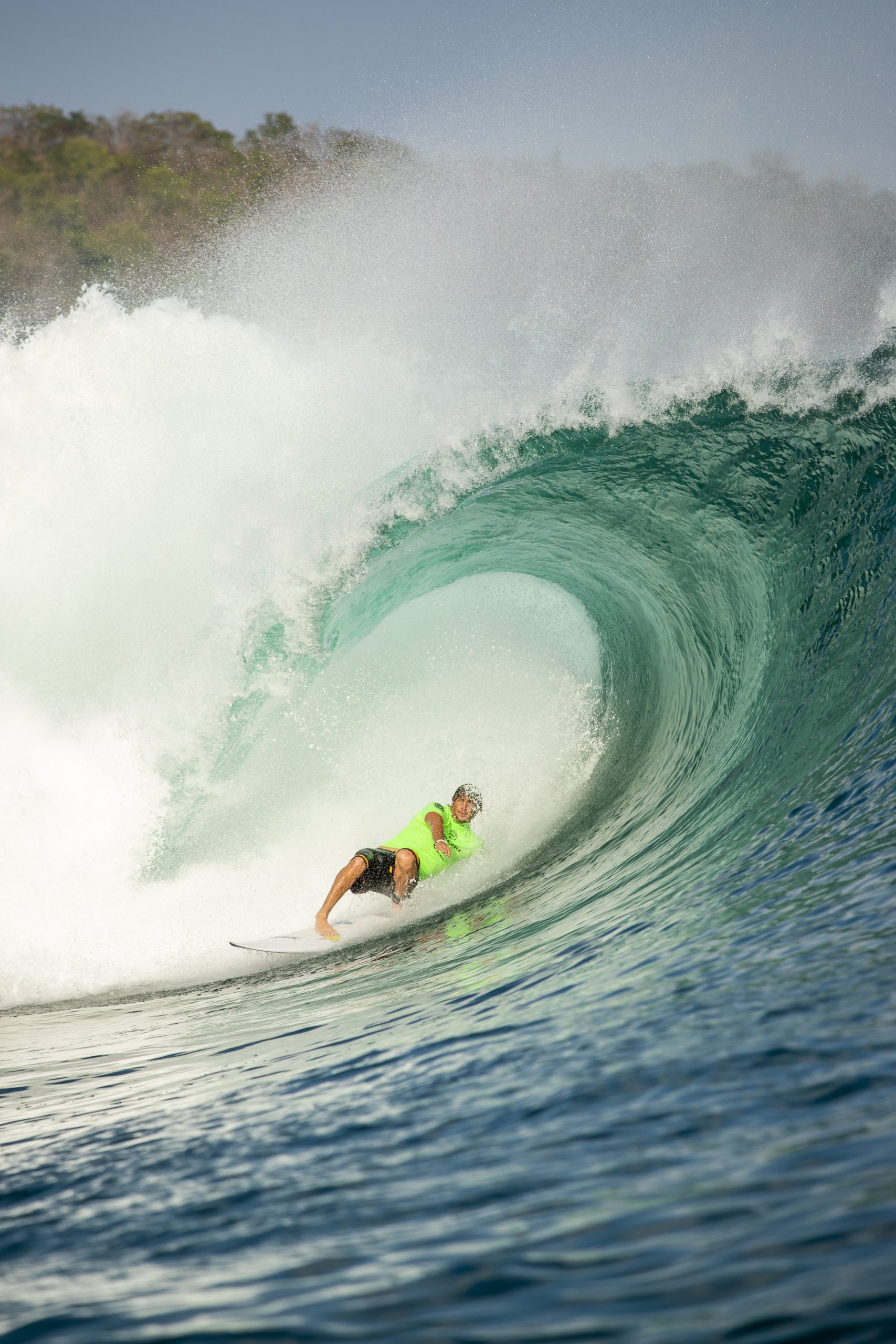Almost The Entirety Of Surfing Is Now Owned And Operated By Non-Surfers—Does It Matter?
The recent Hurley acquisition got us thinking: Without their founders, who’s the gatekeeper of the surfer contracts, the events, the culture?
You might have heard that Hurley, marquee sponsor of 2x World Champion John John Florence and since 2002, a property of Nike, was sold a couple days back to Bluestar Alliance LLC, the parent company of brands including Brookstone, Bebe, Yak Pak, and Limited Too.
Nike did not release the financial details of the transaction, and unless you’re directly involved with the surfing industry, news of a mega-brand (Hurley) being passed from one super-mega-brand (Nike) to another super-mega-brand (Bluestar) is probably not all that interesting.
Because on the surface level, it won’t affect your life in the slightest. Unless of course Hurley’s best products involve the IP of Nike’s tech, in which case you can kiss your light, stretchy boardshorts goodbye.
Thigh chafing aside, the question remains: does it actually matter who owns surfing’s most prominent manufacturers?
Maybe it’s because we’re too close to this whole dog and pony show, but we’d argue yes. Because the decisions that these brands—and most importantly, their new owners—make, shape surf culture as we know it.

Bob Hurley (right) alongside Hawaiian Designer Sig Zane (middle) and some drifter.
Photography
Hawaiian Business
I’m sure plenty of readers will wince at the statement, thinking, “Brands don’t define our culture! Surfing is a personal pursuit and way of life. I haven’t worn a Quiksilver shirt in over a decade and I surf every day. What do we need the brands for?”
I hear you… But give me a chance to persuade.
If you’ve paid attention to the business dealings of surfing’s biggest brands, you’ll know that while most have gone public or joined forces with athletic groups like Nike, it’s still the founders who are controlling the big decisions. But that could be changing.
Below I’ll describe the recent business dealings of surfing’s most prominent brands. Feel free to skip over this section if you’d like, as the details are not central to my argument.
Just a few weeks ago, Rip Curl sold for $236M USD—after functioning for 50 years as a privately owned business—to the adventure brand Kathmandu (KMD), which sells for around $3 NZD on the New Zealand Stock Exchange.
Back in April, Volcom was sold by the Kering Group (KER)—which currently trades for around $510 EUR on the Paris Stock Exchange—to Authentic Brands Group, a private company.
And back in 2018, Quiksilver’s parent company, Boardriders Inc., purchased rival brand, Billabong, after both companies fell into bankruptcy following the 2008 recession. Boardriders Inc. is property of the private hedge fund Oaktree Capital. Both brands are now reportedly on an upward trajectory.
So why does this matter? Who cares which bottomless money pit is funding the production of surfing’s cheaply-made, environmentally indifferent, overpriced T-shirts? They’re all gonna end up in flyover-state Marshalls and Ross Dress For Less anyways.
But here’s the thing: surfer CEOs and founders make brand decisions based on what surfers want. Trained businessmen make brand decisions based on what seems fiscally responsible. The beauty of this discrepancy is that in the surf world, “fiscally responsible” decisions often have a negative effect on sales, because surfers, as consumers, are driven by the same lizard-brain impulses as the Bob Hurleys, Doug Singers, and Gordon Merchants of the world. That’s why surfing’s biggest, best brands were built on the backs of seemingly irrational decisions: paying out huge endorsement contracts to comp-averse surfers, buying multi-million dollar homes on the beach at Pipeline, wrapping a 75-foot yacht in company logos and sailing it to surf spots around the globe, etc.
Most importantly, all the best surf brands invested heavily in their teams. Think:
- Billabong’s Occy, Andy, and Parko
- Volcom’s Bruce, Ozzie, and Noa
- Rip Curl’s Curren, Fanning, Medina
- Quiksilver’s Kelly, Dane, Ando, Steph
- Hurley’s John, Julian, Kolohe, Carissa
All of these surfers have commanded large (occasionally colossus) contracts from their respective brands. And while the numbers might not have always added up, thanks to their love and understanding of the surf world, these founders could always justify the deflated ROIs because of how much cultural capital these surfers provided—especially when the relationships spanned decades. It’s “fiscally irresponsible” decisions like these that paid the companies massive dividends—maybe not in Q2 of the current fiscal year, but in the long, storied history of every successful surf brand.
Shareholders and non-endemic executives will likely not share those same values. Their main concerns will be profit and growth by any means necessary—which on top of pursuing morally questionable business practices, also means trimming expenses. And for most major surf brands, the biggest expenses come in the form of athlete contracts and event sponsorships.
This means both are potentially in danger.
Which brings us to the next point: if surf brands lose their inherent surfing core, will the new decision-makers see value in sponsoring surf events?
Well, we’re already starting to see the effects of that today. First stop, the Eddie.
Still surfing’s marquee big wave event, the Eddie Aikau Invitational at Waimea Bay was sponsored by Quiksilver for more than three decades, but in 2017, Quiksilver’s failure to reach a contractual agreement with the Aikau family resulted in their ongoing separation from the event. While surf culture is widely affected by this loss, Quik left the meeting hundreds of thousands of dollars richer for an event that, historically, only ran every five or so years—a smart decision in the short-run, but what will be the long-term effects?
Next stop, the WSL—who’s fortunate to be bankrolled by a charitable billionaire, as the org has been losing millions year-on-year since its inception (2015, not 307 AD or whatever they like to claim).
In 2019, only four of the 11 Men’s CT events are sponsored by “core” surf brands (Quik Pros Snapper and France, Rip Curl Pro Bells, and the Billabong Pipeline Masters). This number is down significantly from 2010, when 9/10 events were sponsored by endemic brands; 2013, when 10/10 were endemic; and 2016, when 6/10 were endemic; etc. Next year, it’s rumored that Quiksilver will pull its Snapper endorsement (to be replaced by Corona), bringing the total number of events sponsored by endemic surf brands down to 3/11.
Could this be a product not just of the brands’ new, non-endemic leadership, but also the WSL’s, which consists of non-surfers and far-too-recent converts in its executive positions?

The Eddie will (hopefully) continue even without Quiksilver’s support, but the loss of sponsorship will inevitably weaken the event’s grand scale.
Photography
Quiksilver
Since the WSL removed the Lowers event and swapped it for Lemoore*, Hurley, too, has reduced its role from “main sponsor” to “presenting sponsor” at the CT level, and they still haven’t confirmed a partnership with the WSL in 2020.
While correlation doesn’t always equal causation, it is interesting that Hurley’s complete retraction from the WSL will begin in their first year under new management. It also raises the question: how will Rip Curl, who’s also been purchased in 2019, play with the WSL in 2020 and beyond? It’s hard to imagine the Bells event ever going away, but with a large, undisclosed price tag on the heritage event’s head, the folks at Kathmandu could easily say, “Eh, I think we’re good without it.”
And that would be that. Fifty years of history gone with the stroke of a pen. A pen wielded by a man (yes, the Kathmandu CEO is a man, I checked) who’s never slipped into a wet wetsuit, run down that interminable staircase, and gotten washed from the Bowl to the Button on a poorly-timed paddle out.
Same goes for the expensive but culturally invaluable Rip Curl Cup Padang, which sparks some of the world’s most inspired tube-riding.
Think it couldn’t happen? Look at what Kathmandu CEO, Xavier Simonet, had to say about his method of increasing net profits by 23% in 2018:
“What’s happened in the first-half is [the result of] a focus on margin expansion, increasing our margin but also a very tight control on costs.”
A very tight control on costs.
And just imagine how much money Rip Curl would save if they eliminated Bells and Padang, halved Fanning’s still-seven-figure contract, and clipped old man Curren from the payroll.
The same goes for Occy and Pipeline with Bong; Snapper, France, and Steph with Quik. John John and the actual Hurley sons (who hope to retain their roles within the family company following its sale) with Hurley. The list goes on.

Please don’t take our beloved Clay-backs, Mr. Simonet!
Photography
Rip Curl
Now you’re probably thinking: “Well what do the WSL, and pro surfers in general, have to do with my surfing experience? I haven’t watched a heat all year—ok, maybe a couple at Teahupo’o, but that’s it!—so I fail to see how I, or “surf culture” for that matter, would be deeply affected by corporately-managed brands.
If you really feel that way, I won’t argue. Perhaps your surfing experience is so isolated and unique that all you need are waves, a board, and a bar of wax to be content. But not me. I love this shit on every level: the performances, the big-ticket sponsorships, the team films, the brand hits and misses, the infighting and drama, the gossip, the corny campaigns, the Title races, the stickers getting torn off or freshly massaged onto crisp white noses.
And a lot of that stuff—not all of it, but a significant amount—falls by the wayside if we don’t have surf-first brand leaders putting their necks, and most importantly, their checks, on the line to promote the vision of surfing that we all know and love.
Here’s to hoping that “fiscally responsible” spending and ROI reports don’t dissolve our salty nucleus.
*This is, in fact, the way it went down—don’t let Slater tell you otherwise. When Hurley asked about sponsoring the Lowers event again in 2018, the WSL said, sorry, that event no longer exists!





Comments
Comments are a Stab Premium feature. Gotta join to talk shop.
Already a member? Sign In
Want to join? Sign Up